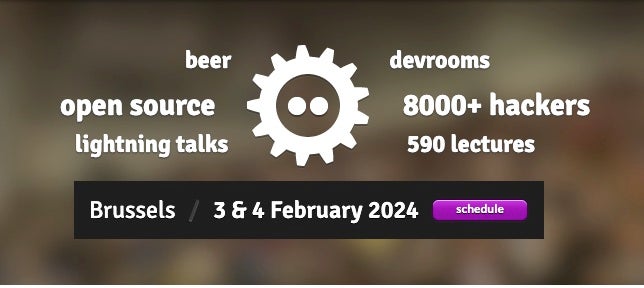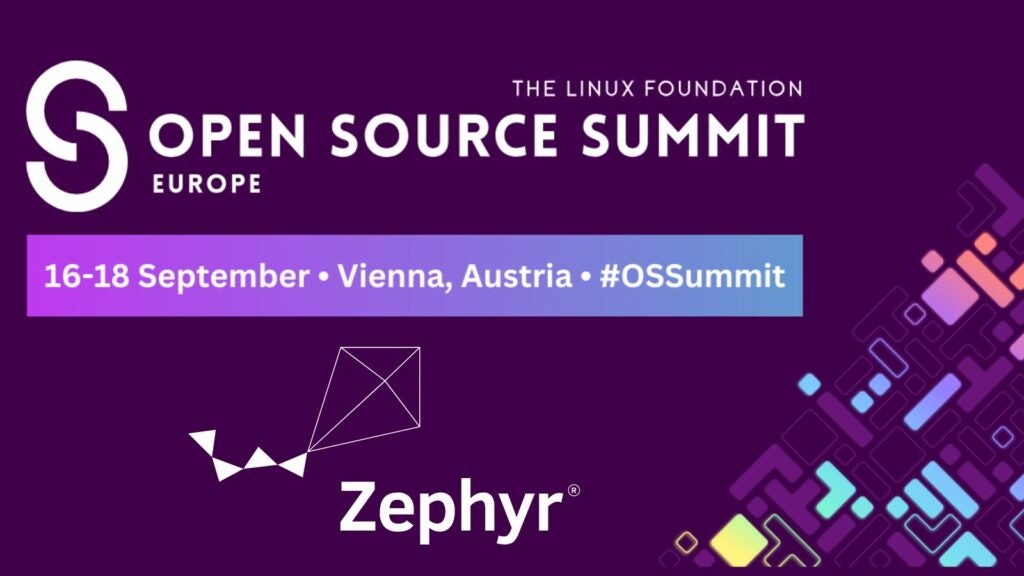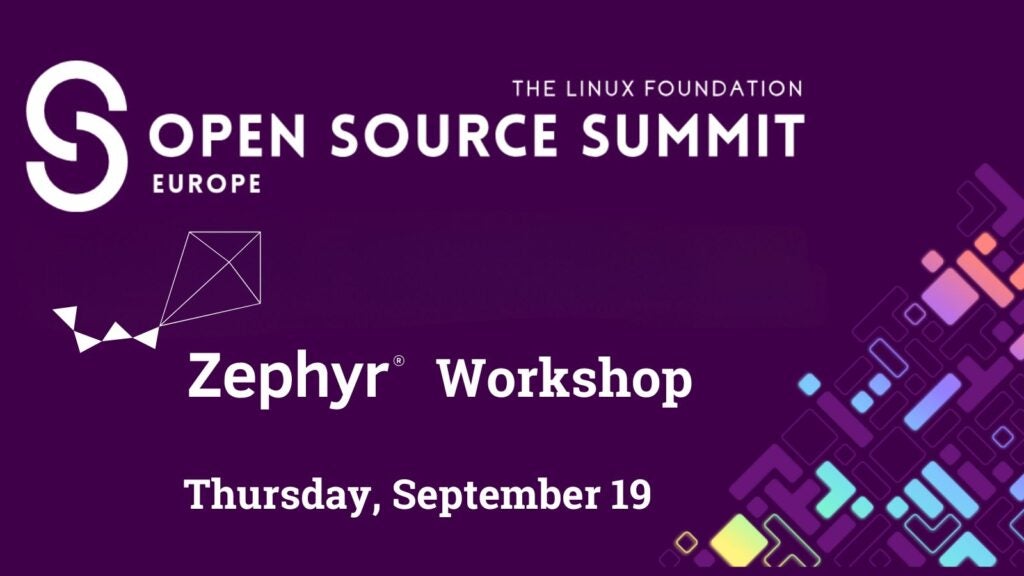FOSDEM, which takes place on February 3-4 in Brussels, is a free event for software developers to meet, share ideas and collaborate. Every year, thousands of developers of free and open source software from all over the world gather at the event in Brussels. This event is expecting 636 speakers, 591 events, and 65 tracks.
Zephyr will be featured in several presentations. For more information or to register for the event, visit the FOSDEM website.
Saturday, February 3:
11 – 11:25 am: Introducing Sound Open Firmware project – Daniel Baluta
Sound Open Firmware is an open source audio DSP firmware and SDK that provides audio firmware infrastructure and development tools for developers who are interested in audio or signal processing on modern DSPs.
Sound Open Firmware is supported on platforms from Intel, NXP, Mediatek and AMD. It comes with Linux kernel ALSA driver and open source firmware. Past year saw a major effort on integrating Sound Open Firmware with Zephyr RTOS.
The goal of the presentation is to offer a gentle introduction to the project, building blocks, community and tools.
Project page: https://www.sofproject.org/ Project documentation page: https://thesofproject.github.io/latest/index.html
12:00 pm – 2:00 pm: Zephyr Project Hour at the cafe in building F
Are you interested in learning more about Zephyr? Come meet the developers, engage in conversations, and enjoy a casual and friendly environment. Whether you’re a seasoned developer or just starting out, seize this perfect opportunity to network, ask questions, and gain insights into the Zephyr project.
We look forward to seeing you there!
2:30 pm – 2:55 pm: Power to the People – Technology for Access to Energy – Vivien Barnier & Martin Jäger
The world has made great progress in providing everyone with access to energy; however, recently, the number of unelectrified people on Earth has increased. Providing access to energy is a critical and complex challenge as most unelectrified people live in extremely remote and hard-to-reach areas, often having limited mobile network connectivity, unknown (future) demand patterns, and extreme weather conditions combined with very low purchasing power of the affected population. The power of Open Source is still completely underrepresented in technological innovations in this sector. We are working towards improving this situation and will showcase one of our flagship examples: An Open Source Battery Management System (BMS) specifically developed for off-grid energy application. Energy storage and its related technologies are key to any off-grid energy application and the Libre Solar BMS has been specially developed for this use case. We will deep dive into the design decisions and features, covering hardware, firmware and an app. The BMS was developed leveraging solely open source tools: The PCB is designed in KiCad, the firmware runs on Zephyr RTOS and the communication interfaces use the ThingSet protocol over various lower layers like Serial, CAN, WebSocket or MQTT. The hardware went through three design iterations and has been lab and field-tested by several organizations. We will conclude and show why this kind of Open Source technology is of such great importance to bring power to the people in both the sense of bringing electricity literally and also creating the grounds for local value creation in the affected geographies. We invite the whole Energy Open Source community to contribute with their efforts to where the contributions can be most impactful on various levels. The Open Source BMS is one great piece, but we need much more of those.
2:30 pm – 2:55 pm: How open source projects approach Functional Safety – Nicole Pappler & Philipp Ahmann
Open Source is a winning solution for many industries already – and now even safety critical applications want to make use of it. While “security” is a capability of open source since many years, a few years ago using open source in safety critical applications seemed to be impossible even to think about. Nowadays it has become a valid option for upcoming applications. This kind of application that should save lives, or at least not harm anyone. However, with advancements in technology and safety integrity standards, open source is becoming a valid option for upcoming safety critical applications. This talk will provide an overview of how open source projects approach their integration to safety critical applications. Depending on the expectations of these applications, there are different solutions to address their needs. The talk will introduce example projects such as ELISA, the Zephyr Project, and the Xen Project, which are currently addressing these expectations with various mechanisms and approaches.
4 – 4:25 pm: Zephyr and RISC-V: I Ain’t Afraid Of No Ghosts – Mohammed Billoo
RISC-V’s instruction set architecture (ISA) has enabled seasoned embedded software engineers to experiment with FPGAs since numerous open-source RISC-V cores can be flashed onto an FPGA. The Zephyr Project is rapidly emerging as a leading real-time operating system (RTOS). Zephyr integrates open-source and security best practices to ensure a vendor-neutral, secure, and reliable platform.
In this talk, Mohammed Billoo will describe the process of getting to Zephyr to run on the UPduino (https://tinyvision.ai/pages/the-upduino), flashed with the neorv32 RISC-V processor (https://github.com/stnolting/neorv32). He will walk through building and flashing the neorv32 RISC-V core on the FPGA, creating a Zephyr application that can output Hello World to the UART, and loading the application to the FPGA. Mohammed will also walk through the necessary Zephyr drivers to get the application running. This talk will demonstrate how combining RISC-V and Zephyr on an FPGA opens up new opportunities for embedded software applications. Using open-source software and firmware on a low-cost FPGA reduces the bar for entry for enthusiasts and hobbyists. The audience will learn the following in this talk:
- Relevance of the RISC-V instruction set architecture for hobbyists
- Overview and structure of the neorv32 RISC-V processor
- Overview and structure of The Zephyr Project RTOS
- RISC-V support in Zephyr
- Relevant Zephyr drivers
- Demo: From Empty Silicon To Zephyr Boot
5-5:25 pm: From an artificial nose weekend hack to a future-proof IoT device – Benjamin Cabe
It was a long weekend in May 2020. Like many of my human siblings stuck at home with time on their hands due to an ongoing pandemic, I was busy trying to perfect my bread recipe. Fast forward to a few hours later, I had assembled an Arduino-based “artificial nose” that used a gas sensor and AI (so-called TinyML) to learn and detect scents (hence potentially the smell of a perfectly fermented sourdough starter). As I open-sourced and started to share the project on social media, it went viral… and I felt like an impostor, as most of the code powering it was, frankly, hackish. Or maybe it wasn’t, as it had the merit of having helped me invent something new, in literally a few hours.
In this talk I will walk you through some of the key features of the artificial nose, and how I eventually rewrote my original code to leverage Zephyr (an open-source real-time operating system) in order to make it easier for myself and the community to extend the project, and run it on a variety of hardware targets.
You will learn, among other things: * How to move from a complex “super loop” to well architected threads and event-based programming ; * How to run TinyML models (ex. TensorFlow Lite) while not compromising the rest of your embedded system ; * How to build an efficient and easy-to-maintain graphical user interface ; * How to leverage Zephyr hardware-abstraction layer.
All the code and demonstrations shown in the talk is open source and available on GitHub, and you are very much encouraged to go ahead and build your own artificial nose after the presentation!
Sunday, February 4:
12:30 – 1 pm: Application of the SPDX Safety Profile in the Safety Scope of the Zephyr Project – Nicole Pappler, Stanislav Pankevich
Creating and maintaining a safety critical project comes with a lot of challenges. One central issue is keeping your documentation, starting from planning and guideline documents, down to requirements, safety analysis, reviews and tests, consistent and up to date. These project artefacts often have their own lifecycle and are natively managed in different tools, with usually great traceability capabilities regarding dependencies between these artefacts as long as you stay within one tool or within a (usually propriety) tool family of one single tool vendor. Currently the resulting traceability gaps between these tools are handled either by the popular engineering tools like MS Excel or methods like “search for identical names”, depending highly on manual maintenance. Using SPDX relationships, the upcoming Safety Profile in SPDX 3.1 will provide a model to represent all these dependencies as a knowledge model that can be used both to analyse possible impacts after a change (be it because of a security update or functional variants of your product), provide evidence of completeness and compliance as a Safety SBOM or simply keep track of your product variants. In this talk we will provide both an introduction to the SPDX Safety Profile as well as a real life example using StrictDoc and the Zephyr Project’s Functional Safety scope.
Check out the complete schedule and dev rooms like SBOM, Embedded, Automotive and more. https://fosdem.org/2024/




